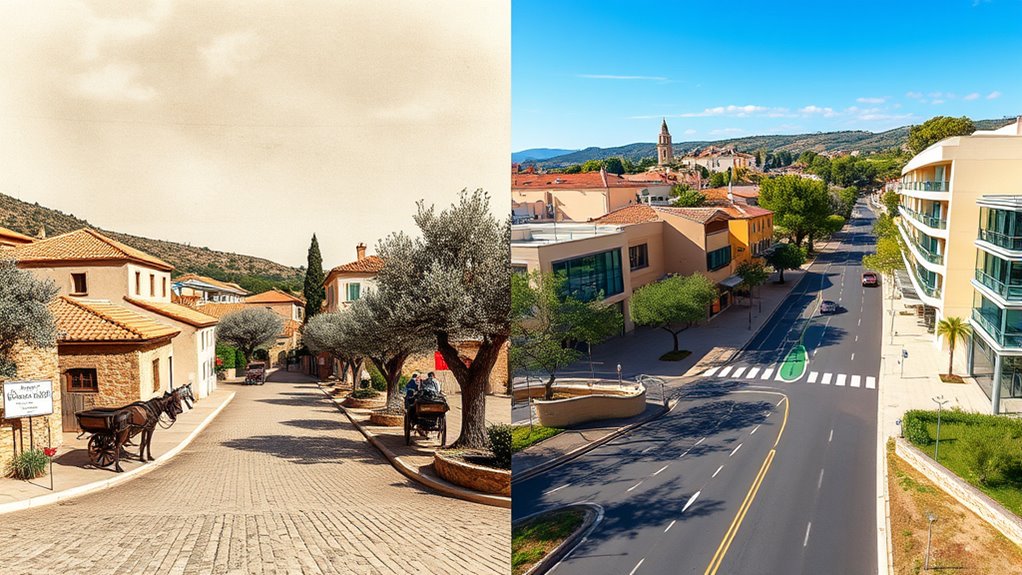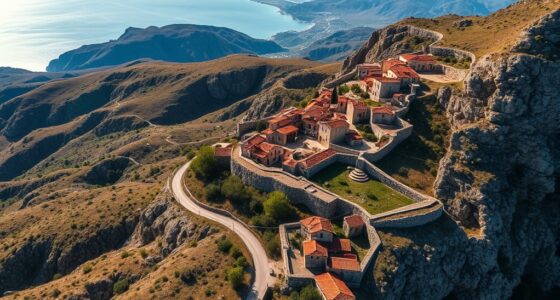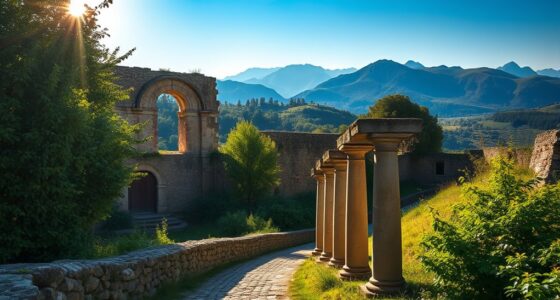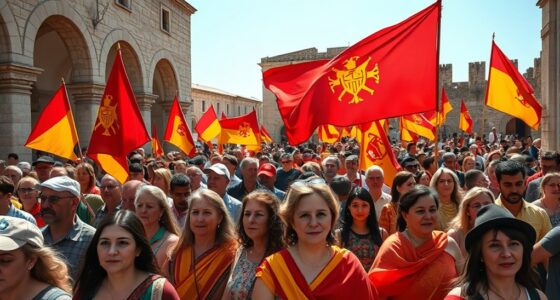Historical photos of Ittiri reveal its fascinating evolution from prehistoric Nuragic sites and ancient tombs to Roman settlements and medieval abbeys. You can see how the town’s architecture and streets have transformed over centuries, blending old sacred sites with modern structures. The contrast between then and now highlights community growth and preservation efforts. Explore further to discover the stories behind these images and how Ittiri’s heritage shapes its identity today.
Key Takeaways
- Historical photos of Ittiri showcase the town’s architectural evolution from medieval, Romanesque, Gothic, to modern styles.
- Visual collections highlight changes in street layouts, building facades, and urban development over time.
- Images depict the preservation and restoration efforts of sacred sites like Santa Maria di Coros and abbeys.
- Old photographs reveal traditional lifestyles, craftsmanship, and community life in different historical periods.
- Comparing then and now illustrates Ittiri’s cultural continuity amid modernization and urban renewal.
The Ancient Nuragic Roots of Ittiri
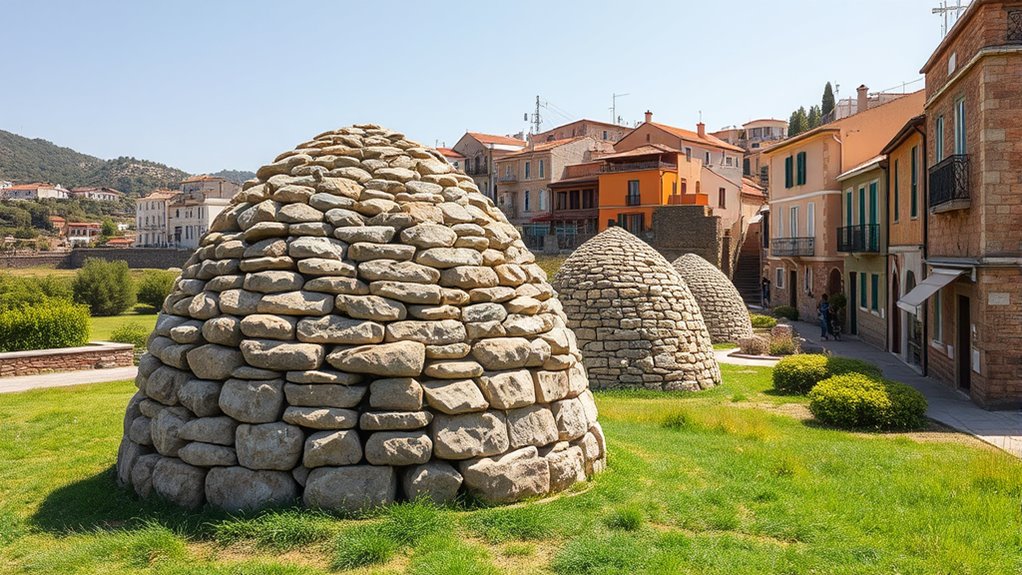
The ancient Nuragic roots of Ittiri reveal a rich history that predates recorded civilization, stretching back to the late Neolithic and Middle Bronze Age. You can explore remains like the Sa Figu necropolis, which includes eleven hypogean sites with rock-cut chamber tombs called domus de Janas. Nearby, you’ll find a proto-nuraghe and a megalithic circle made of orthostatic boulders, highlighting prehistoric craftsmanship. Additional necropolises, such as Ochila, feature richly decorated tombs, suggesting complex ritual practices. Hypogeum sites like Musellos and Runara include dolmens, with one still intact, and menhir alignments, indicating elaborate burial customs. These early monuments reveal Ittiri’s significance long before the Nuragic civilization emerged, highlighting the prehistoric architectural achievements that shaped the region’s cultural landscape. These archaeological findings demonstrate the area’s importance in prehistoric Sardinia and provide insight into early social and spiritual life.
Roman Influences and Early Settlements
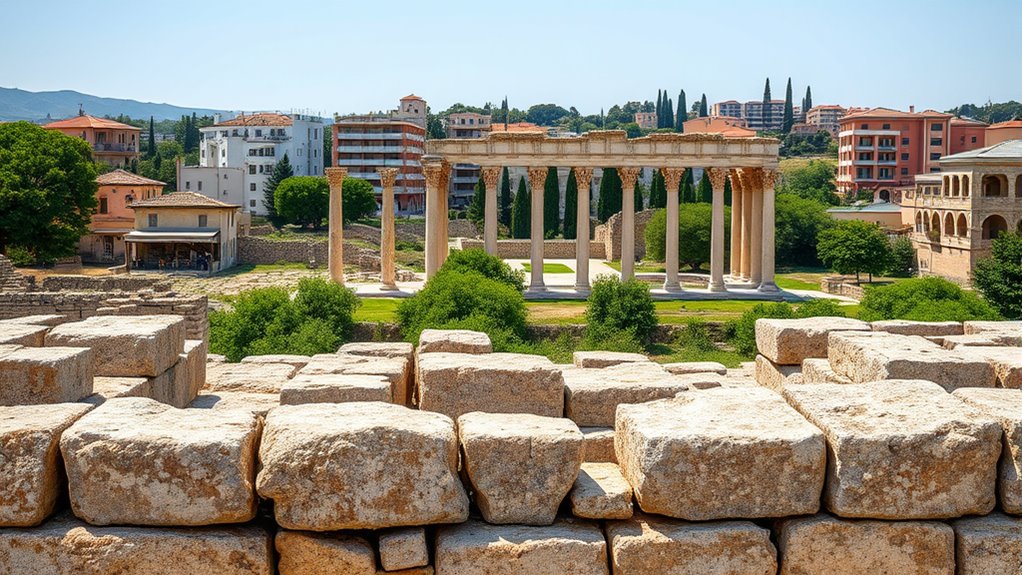
Roman conquest transformed Sardinia, including the Ittiri region, bringing lasting changes to its landscape and society. When the Romans took control in 238 BC, they introduced Latin language, Roman laws, and new religious practices that blended with local beliefs. You can see remnants of their presence in roads, bridges, and urban planning, although Ittiri itself has fewer documented Roman sites. Roman agricultural techniques, such as viticulture and olive cultivation, boosted the local economy, especially in rural areas. Roman settlers, veterans, and infrastructure connected Sardinia to the wider empire, shaping its development. Over time, Roman culture, legal systems, and trade networks left a deep imprint, even as local communities like Ittiri retained their Nuragic roots amidst these influences. Archaeological excavations continue to reveal artifacts and structures that testify to Roman presence and activity in the region. Additionally, the adoption of Roman urban planning contributed to the development of local settlements and infrastructure.
Medieval Foundations: From Abbeys to Villages
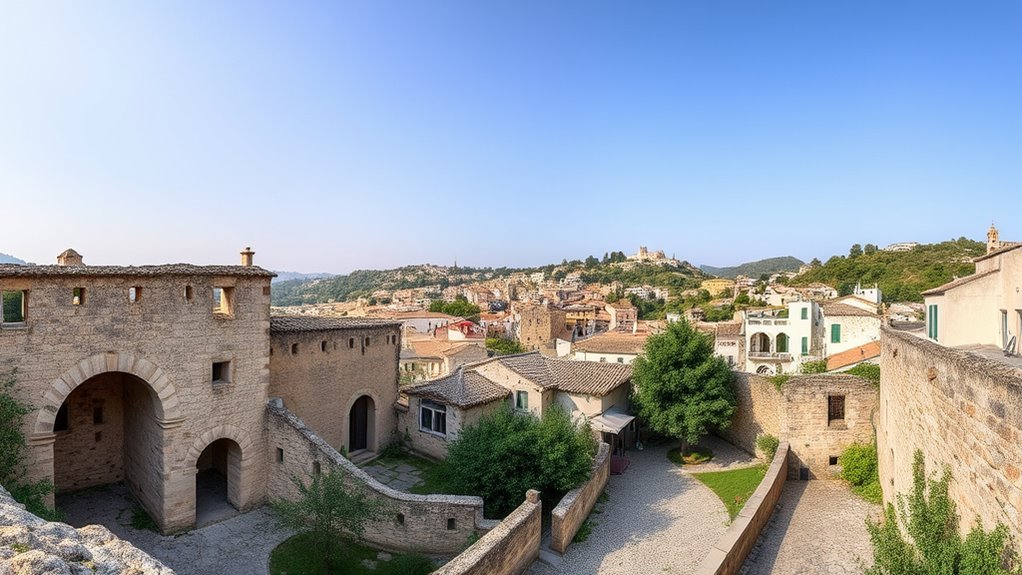
As Sardinia’s landscape evolved through Roman influence, the medieval period brought a new wave of religious and community development. You’ll find that abbeys like Paulis and Nostra Signora di Coros, built in the 13th century, showcase Romanesque and Gothic styles. These structures, such as:
- Were established by Cistercian monks starting around 1000 AD.
- Include features like limestone walls and symbolic windows representing the Trinity.
- Served as spiritual centers along Roman roads, with remains of cloisters and convents still visible today.
- Named by Ptolemy in the II century CE as part of the Nuragic tribe Coracenes, the region has been a continuous hub of settlement and religious activity. The archaeological remains found in these sites provide valuable insights into Sardinia’s medieval history.
Surrounding villages like Usini, Tissi, and Olmedo have roots stretching back to medieval or prehistoric times. These settlements reflect Sardinia’s long history of agriculture, archaeology, and cultural continuity, linking past to present.
The Architectural Evolution Through the Centuries
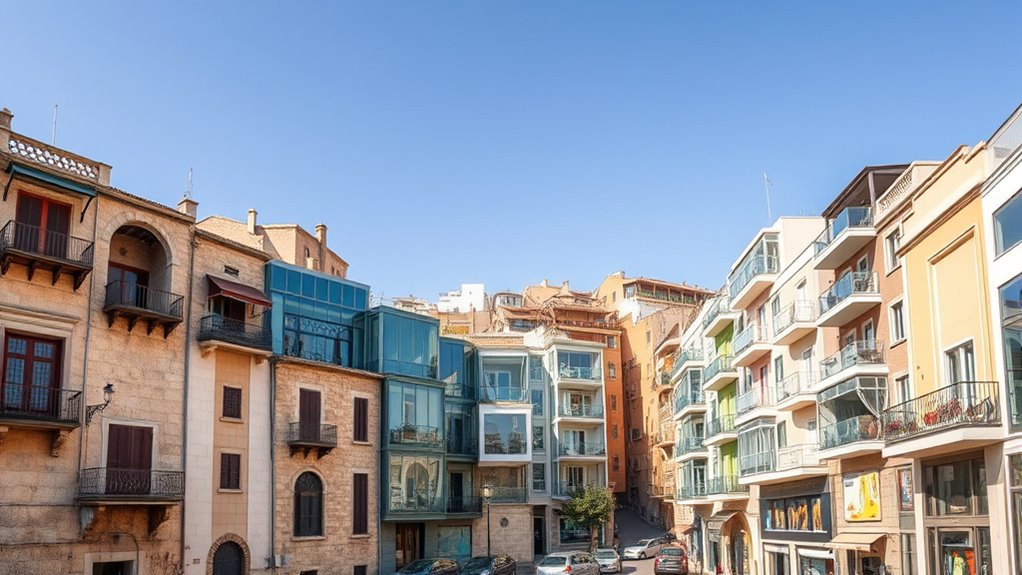
Architectural evolution in Ittiri reveals a layered history shaped by diverse influences and changing tastes over centuries. You’ll notice remnants of Romanesque and Gothic styles, like the thirteenth-century Nostra Signora di Coros church with its medieval techniques and rare ogival barrel-vaulted roof. Over time, Pisan, Lombard, Provençal, and Arab craftspeople left their mark, blending styles into unique local architectures. During the sixteenth and seventeenth centuries, sacred buildings like Santa Maria di Coros saw Gothic features replaced or buried beneath Baroque additions, reflecting liturgical shifts. In the late 1800s, the neoclassical San Pietro underwent a major facelift, using local volcanic stone and classical forms, marking a shift toward historicism. The twentieth century prioritized modernization, often neglecting or removing older structures, reshaping Ittiri’s architectural landscape. Construction techniques evolved with the development of new materials and engineering methods, influencing subsequent restoration and building practices.
Religious Heritage and Sacred Sites
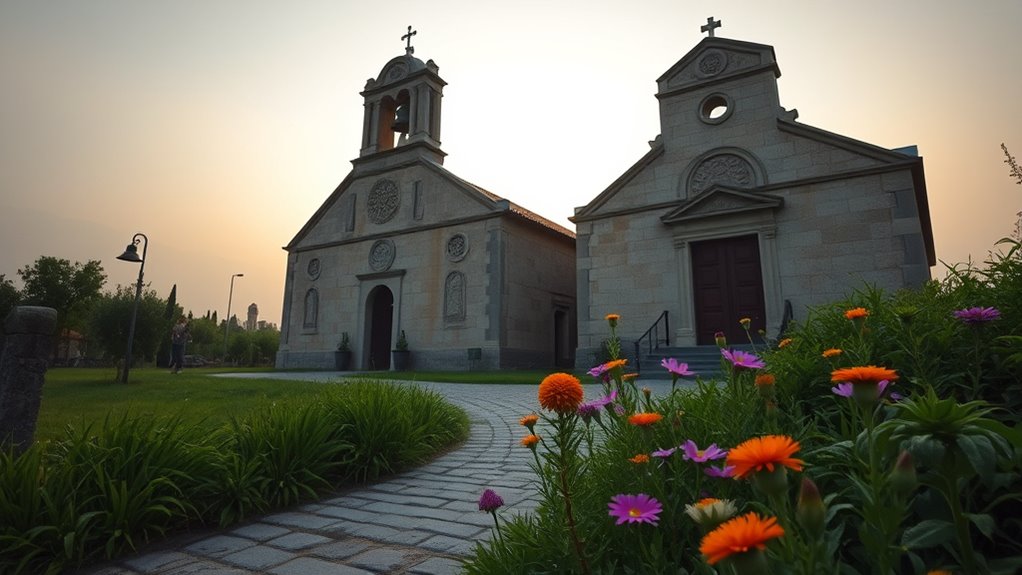
You can explore Ittiri’s ancient sacred structures, like the Church of Santa Maria di Coros and the abbeys of Paulis and Nostra Signora di Coros, which reveal its rich medieval religious history. Restoring these sites helps preserve their architectural and cultural significance for future generations. These efforts also highlight the ongoing importance of sacred places in shaping Ittiri’s heritage. The preservation of these sites is essential for maintaining the historical continuity and spiritual identity of the community. Additionally, maintaining these supportive structures ensures that the historical integrity of the sites endures over time.
Ancient Sacred Structures
Ancient sacred structures in the Ittiri region reveal a fascinating evolution from simple huts to sophisticated temples, reflecting changing religious practices and social hierarchies. You’ll notice three key developments:
- Early structures began as basic huts, evolving into stone foundations with tile roofs between the 7th and 6th centuries BCE. The transition to more durable materials signified an increased investment in religious architecture.
- Architectural plans diversified into small rectangular buildings, often with one or two rooms, leading to monumental temples with elevated podia by the 6th century BCE.
- Temples and altars, sometimes separate, incorporated cosmic symbolism through orientation and geometry, linked to larger ritual landscapes.
Materials like locally quarried stone guaranteed durability, emphasizing the importance of these sites for elites and religious leaders. Over centuries, sacred structures became symbols of cosmic order and cultural identity.
Restoration of Religious Sites
Restoration of religious sites in Ittiri plays an essential role in preserving the region’s cultural and spiritual heritage. The Chiesa di San Leonardo di Cuga, dating back to the late 12th century, has undergone continuous preservation efforts, including a major restoration in 1538 and a strategic relocation in the 20th century to protect it from dam construction. Its new location along SS131bis maintains its regional significance. Similarly, the Abbey of Our Lady of Paulis, founded in 1205, has been repeatedly restored to safeguard its monastic legacy, featuring typical Cistercian architecture. These efforts aim to recover entire religious complexes, including surrounding gardens and structures, ensuring their ongoing spiritual use and cultural relevance. The 20th-century relocation was a significant intervention that exemplifies adaptive preservation techniques, which are vital for balancing conservation with modern needs.
Urban Development and Street Layouts
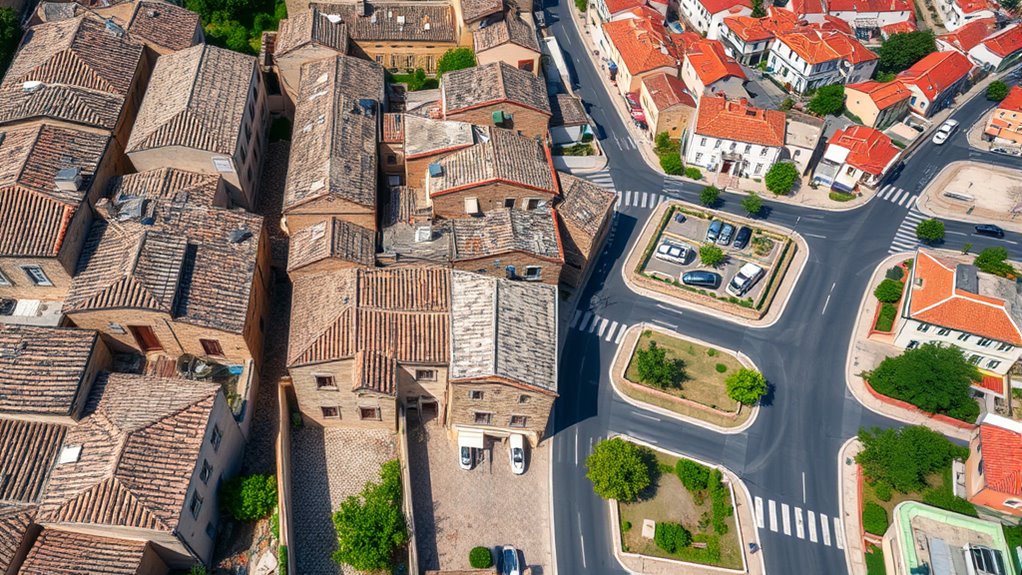
Ittiri’s urban development reflects a blend of historical influences and geographical constraints that shape its street layouts today. You’ll notice that the original settlement patterns follow the rugged, hilly terrain, with streets winding along natural contours. Over time, three key changes occurred:
- Modernization led to the widening of main roads and the creation of new streets for vehicle access.
- Outside the historic core, grid-like, orthogonal street layouts emerged, contrasting with the older irregular patterns.
- Geographic features such as hills, valleys, and watercourses dictated street alignments, often following natural contours to ease movement. This approach aligns with Relationships – Personality Test principles, emphasizing the importance of understanding natural flow in urban design.
- The preservation of certain ancient pathways demonstrates an effort to maintain historical continuity within the town’s evolving layout.
Despite these changes, efforts preserve the historic street layout within the old town, maintaining its cultural and architectural charm amid contemporary growth.
Traditional Crafts and Rural Economy
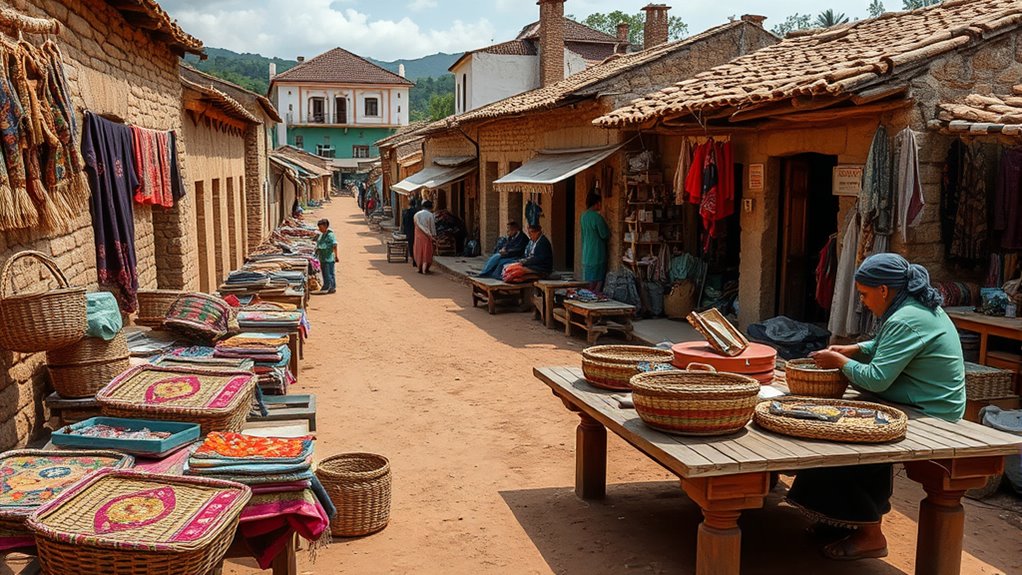
Traditional crafts in Ittiri have evolved over centuries, forming an essential link between the town’s cultural heritage and its rural economy. You can trace these crafts back to the Nuragic era, with early artisans working in iron, ceramics, stone, and wood, influenced by Romans, Vandals, and Byzantines. During medieval times, markets and fairs boosted craft production, supporting local trade. Despite setbacks during the Spanish period, church and aristocracy commissions kept craftsmanship alive. In the 18th century, new workshops flourished under the Kingdom of Sardinia, specializing in textiles, embroidery, and stonework. Today, olive groves, vineyards, and traditional basket weaving sustain the rural economy, while craft workshops continue to preserve these skills, intertwining cultural identity with economic activity. The preservation of these crafts is also supported by local festivals and cultural events that celebrate Sardinian heritage, attracting visitors and encouraging the transmission of skills to younger generations. Additionally, traditional craftsmanship plays a vital role in maintaining the unique cultural landscape of Ittiri, reinforcing community pride and identity.
Modern Changes and Preservation Efforts
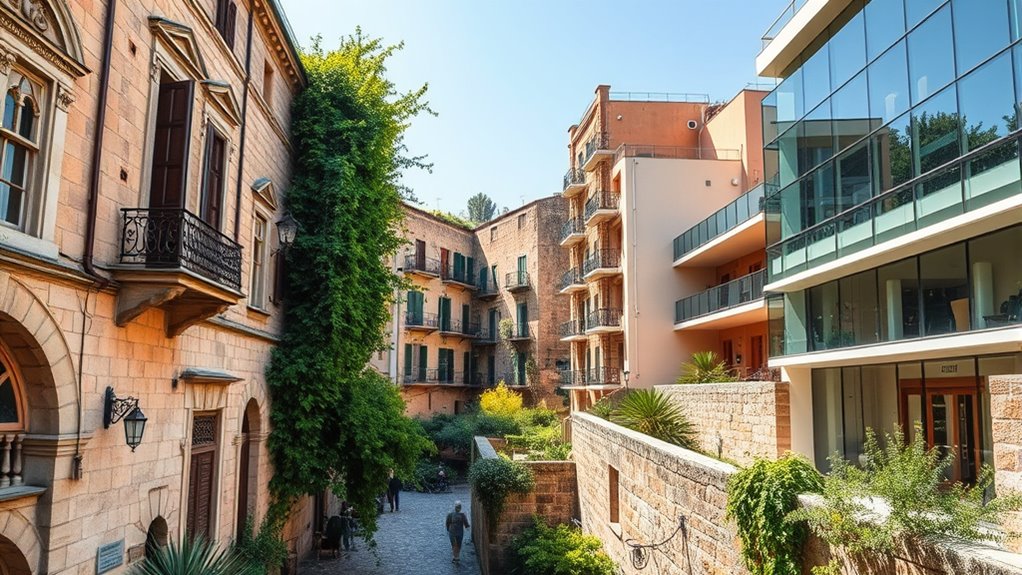
Modern changes in Ittiri and other Sardinian villages are driven by urban regeneration projects that aim to breathe new life into historic spaces. These initiatives focus on repurposing abandoned areas for cultural activities, boosting community engagement, and attracting tourism. You’ll see efforts like:
- Creating versatile public spaces for social events, performances, and leisure.
- Involving local volunteers and creatives in workshops to foster ownership and pride.
- Balancing heritage preservation with modern needs, ensuring sustainable development.
- Projects like Fronte Mare in Argentiera exemplify how innovative design can reconnect communities to their maritime heritage while providing spaces for social and cultural interactions. Fronte Mare is a prime example of how contemporary architecture and community participation can revitalize historic settings. Emphasizing cultural heritage preservation ensures that these efforts honor the unique history of Ittiri and surrounding areas. Regional planning now emphasizes environmental harmony, protecting landscapes from overdevelopment. Innovative programs, like offering affordable homes and supporting local products like Ittiri Fresa cheese, help combat depopulation while preserving cultural identity. These efforts blend tradition with progress, shaping Ittiri’s future.
Visual Stories: Comparing Past and Present Images
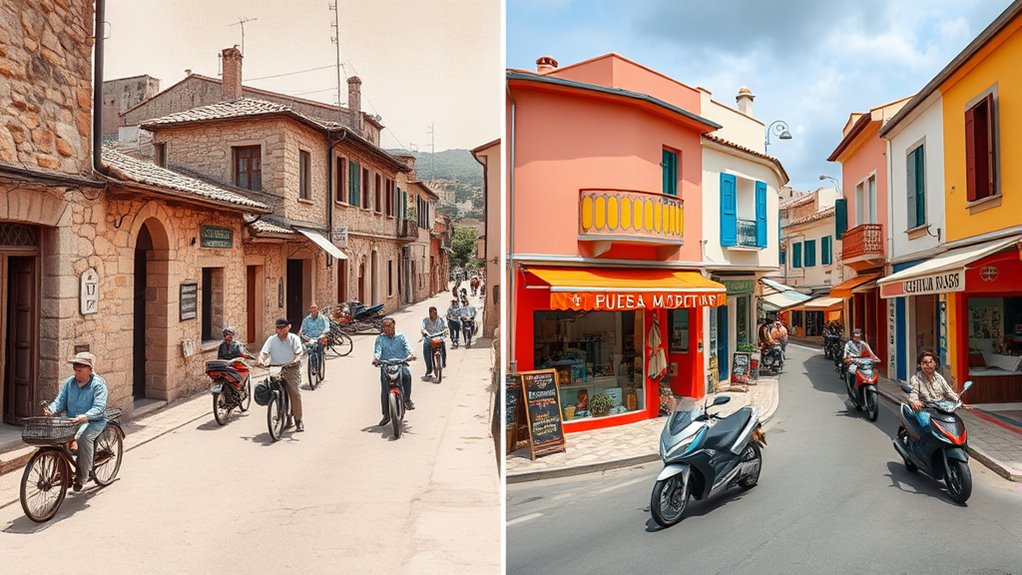
You can see how Ittiri’s architecture has evolved by comparing old photos with current images, noting which structures have been preserved and which have been modernized. The blending of historical elements with new restoration efforts highlights the town’s respect for its heritage while embracing change. Similarly, traditional cultural practices are captured over time, showing both continuity and adaptation in Ittiri’s vibrant community. Photographs taken at different times reveal the ongoing story of Ittiri’s development and preservation, emphasizing the importance of heritage conservation in maintaining the town’s unique character.
Architectural Evolution Over Time
By examining past and present images of Ittiri’s architecture, you can see how the town’s buildings have transformed over centuries. You’ll notice three key aspects:
- Medieval structures like Santa Maria di Coros retain elements such as ogival barrel vaults, but they’ve been altered with Renaissance and neoclassical additions. First documented in 1553, indicating their long-standing historical significance and continuous evolution through different architectural periods.
- Architectural styles have evolved from Romanesque and Gothic in religious buildings to Baroque and Liberty influences in secular structures, often using local trachyte stone.
- Modifications, like the reconstruction of church façades and roofing styles, visually mark shifts from medieval craftsmanship to modern aesthetics.
Photographs reveal how original features have been preserved or adapted, illustrating the town’s layered history. These changes highlight Ittiri’s ongoing effort to blend tradition with modernization while respecting its architectural roots.
Cultural Heritage Preservation
Historical images of Ittiri serve as powerful tools to visualize how the town’s cultural heritage has evolved while maintaining its core identity. You can see how community involvement in festivals, crafts, and folk practices keeps traditions alive, linking past and present. Local pride fuels efforts to preserve historic sites and intangible customs, with residents sharing oral histories and stories that enrich visual archives. Visual stories, comparing old and new photos, reveal changes in landscape use and cultural activities, helping you understand heritage continuity. Guided tours at Mount Torru connect visitors directly to archaeological sites, reinforcing preservation. Support from regional authorities through grants and community initiatives ensures ongoing conservation efforts, strengthening Ittiri’s unique cultural identity. Recognizing the importance of heritage preservation, local organizations actively promote educational programs to increase awareness and appreciation among younger generations.
Frequently Asked Questions
How Have the Religious Sites in Ittiri Changed Over Time?
You see that the religious sites in Ittiri have evolved considerably over time. They’ve been restored, expanded, and relocated to preserve their importance, like San Leonardo di Cuga, which was moved to protect it from flooding. Architectural styles blend Romanesque, Gothic, and local influences, reflecting centuries of change. Despite these modifications, they remain essential cultural landmarks, connecting you to Ittiri’s rich history and spiritual heritage.
What Specific Architectural Styles Are Visible in Old Versus Modern Photos?
You notice that old photos of Ittiri showcase medieval and Baroque styles, with ornate façades and preserved nuraghes. In modern images, these traditional elements blend with Liberty and Art Deco influences, using materials like trachyte. Modern buildings preserve historical charm but also introduce contemporary designs, creating a harmonious mix. You see a strong emphasis on conservation, ensuring that Ittiri’s architectural history remains visible while embracing new styles.
How Did Rural Traditions Influence Ittiri’s Urban Development?
Did you know that over 60% of Ittiri’s land is dedicated to agriculture, shaping its urban growth? You can see how rural traditions influence its development through the use of dry-stone walls and terraced landscapes, blending farmland with settlement patterns. These practices preserve a rural character, with artisanal craftsmanship reflected in architectural details and public sculptures, reinforcing a deep connection between Ittiri’s rural roots and its evolving urban identity.
What Restoration Efforts Have Preserved Ittiri’S Historic Monuments?
You see that Ittiri’s historic monuments have been carefully preserved through various restoration efforts. The Chiesa di San Leonardo di Cuga was dismantled and relocated to save it from flooding, maintaining its medieval features. The Parish Church of San Pietro was renovated with neoclassical updates while preserving Gothic elements. Additionally, Nuragic sites like Su Nuraxi are protected through UNESCO recognition and archaeological research, ensuring their ongoing preservation and cultural significance.
How Do Old Images Reflect Ittiri’S Evolving Cultural Identity?
You can see how old images reflect Ittiri’s evolving cultural identity by showcasing its rich layers of history, from Nuragic relics to medieval churches and modern structures. They capture rural traditions, folk celebrations, and community life, illustrating continuity and change over time. These photos reveal how past customs, architecture, and practices shape today’s identity, helping you appreciate how Ittiri’s cultural roots remain alive amid progress and modernization.
Conclusion
As you explore Ittiri’s transformation from ancient roots to modern streets, remember that history is a mirror reflecting our future. While progress brings change, preserving its heritage guarantees the true spirit remains alive. Like the saying goes, “You can’t go home again,” but you can carry its essence forward. By appreciating both past and present, you help keep Ittiri’s rich story vibrant for generations to come.
